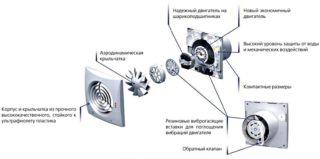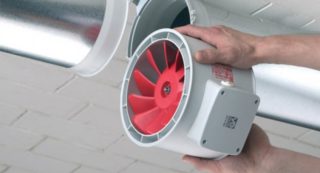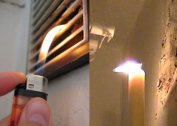Duct devices are one of the most common devices for moving clean air. They are used in everyday life, public places and various industries. In order to ensure that the room is supplied with fresh air, a duct fan must be installed correctly.
Channel Fan Definition
The devices are designed to generate a pulse that provides the air flow with energy to move in a certain direction. The connection of such a fan is usually done by incorporating it into the duct rupture. The parameters of the created flow depend on the internal structure of the system. Devices can work with air masses with temperature up to 80 ° С.
The characteristics of the resulting flow can be controlled (to some extent) by adjusting the speed of rotation of the wheel. The configuration of the ducts has unequal values of air pressure at the beginning and at the end. Using the device, you can flexibly compensate for changes caused by fluctuations in the external or internal environment of the room.
Device and principle of operation
The case of the device can be made of metal or plastic. The most resistant to corrosion are galvanized steel products. To improve the noise insulation qualities, the walls are made of several layers.
The design also includes the following elements:
- impeller, on which the efficiency of the device depends;
- Electrical engine;
- a rotating impeller with blades attached to it (the latter provide the movement of air masses in a certain direction);
- thermal block, thanks to which the fan can function in case of temperature changes;
- lattice elements mounted on the walls and protecting the duct from clogging.
Often devices are also equipped with a speed controller. A capacitor can be used for starting. Some models are equipped with a check valve that does not allow air to move from the street to the building. This element may depend on the sensor or close spontaneously when the flow stops.
When the wheel rotates, a low pressure area occurs, air is sucked in through the grating parts and goes to the blade surfaces. The pressure rises and the flow moves along a network of air ducts in a certain direction. Prevention of overheating is provided by thermal contacts that open the circuit when the temperature rises.
Types and design features
Before installing a channel fan, you need to decide on a model that is suitable for a specific task. Devices differ in a number of ways.
By appointment
Fans for exhaust realize the discharge of exhaust air masses to the outside. Inlets, on the other hand, provide fresh air. Models with a reverse function handle both tasks. This is achieved by changing the direction of travel of the rotor device and the impeller.
Appliances intended for domestic use have low power and are able to serve a limited space. Fans designed for the industry are very powerful and often oversized. Some of them, when turned on, generate a lot of noise.
In shape
The shape of the product depends on the cross section of the air duct where it is planned to be mounted. Round pipe models are the most popular.Rectangular appliances are less common. The most common type is square-shaped fans. They have the highest resistance value.
By design
Axial models consist of a cylindrical body, an engine and blades attached to its axis. These are not very powerful products intended for use in everyday life. Usually, they produce almost no noise during operation. Installation of such a duct fan is easy to do at home.
In devices with a radial movement of air, it is discarded by centrifugal force arising from the torsion of the blade mechanism. Thanks to its compact design, installing a fan in the duct is straightforward. When the blades are directed backward, power decreases, but less noise is also generated and energy consumption from the mains is reduced.
Diagonal designs combine axial and radial movement of air masses, which ensures their high efficiency. At the same time, such models have small dimensions and produce little noise. The scope of these devices is wide.
Tangential devices are used in some industrial installations. The air flow in them moves along the perimeter of the wheel.
A young development can be called centrifugal models, which have sufficient power with small dimensions and low noise generation.
According to the operating conditions
Most fans are designed to operate in a natural environment, but there are special models for special conditions. For example, appliances designed for fire hazardous conditions are made from materials that do not deform at high temperatures. They produce special models for industries working with explosive compounds, as well as for air with high dust content. There are also devices with increased heat resistance - such a fan can be connected in a bath or sauna to remove excess steam. They are also used in industry when working with stove and fireplace units. Ventilation units can have manual or automatic control.
Advantages and disadvantages
The devices are attractive due to their easy installation and wide scope of applications. Most of them work quietly. They do not require special care - it is enough to wipe the case and blades from dust every few months. The electric motor is protected from power surges, which minimizes the probability of failure.
Minus fans - lack of air filtration option. If there is a need for it, it is advisable to install other devices, for example, air purifiers.
Application area
Duct fans are used in households, in commercial premises (shops, catering establishments and others). For narrow industrial purposes, models with special properties are designed. There are models adapted for high humidity conditions, such as bathrooms and toilets. It is possible to arrange the hood mounting so that it turns on simultaneously with the lighting. One of the supply conductors is opened and connected to a switch. If the latter has two buttons, they do it differently: one of them is connected to the lighting device, the other to the ventilation one.
Channel fan installation
Before connecting the channel fan, you need to study the circuit recommended by the manufacturer on the package. For domestic use, it is easiest to install the device in the air inlet. Dimensions are selected, focusing on the cross section of the duct pipe. Home appliances are 9-30 cm in diameter.
The axial device is fixed with brackets to the wall or ceiling hole. It is connected to the air duct by means of nozzles. The slots are closed with a sealing compound.To the beginning of the air duct, a grill is fixed, which prevents clogging. The installed device is connected to the network.
Duct fans are designed for continuous operation, do not need complicated maintenance. Light weight allows you to mount the device on your own.







